Porsche Model Guide
A Porsche History & Road Car Model Guide is shown below, see also my 911 page
Porsche Model Quick Reference Timeline
(click on model names to go to further info):
| 1960s | 1970s | 1980s | 1990s | 2000s | |||||||||||||||||||||||||||||||||||||||||||||
| 0 | 1 | 2 | 3 | 4 | 5 | 6 | 7 | 8 | 9 | 0 | 1 | 2 | 3 | 4 | 5 | 6 | 7 | 8 | 9 | 0 | 1 | 2 | 3 | 4 | 5 | 6 | 7 | 8 | 9 | 0 | 1 | 2 | 3 | 4 | 5 | 6 | 7 | 8 | 9 | 0 | 1 | 2 | 3 | 4 | 5 | 6 | 7 | 8 | 9 |
| 911 (964) | 911 (993) | ||||||||||||||||||||||||||||||||||||||||||||||||
| Panamera | |||||||||||||||||||||||||||||||||||||||||||||||||
See here for chassis numbers
1875
On September 3, Ferdinand Porsche is born in the Bohemian town of Maffersdorf. In 1889, after attending grammar school there and the Staatsgewerbeschule (State Vocational School) in Reichenberg, he enters his father’s business as an apprentice plumber. Ferdinand Porsche married Aloisia Johanna Kaes in 1903. The marriage produced two children, Louise and Ferdinand Anton Ernst (Ferry). His daughter Louise later married the Viennese attorney-at-law Dr. Anton Piëch.
Hybrid Cars
1900

The Lohner-Porsche electric car is presented at the World Fair in Paris. The wheel hub engines of the young engineer Ferdinand Porsche bring him international attention. In the same year, he develops an all-wheel-drive racecar, as well as a hybrid petrol/electric vehicle, a world first.
Daimler
1906
Ferdinand Porsche becomes Technical Director at Austro-Daimler in Wiener Neustadt. At the age of only 31, he is responsible for the model range of one of Europe’s largest automotive concerns.
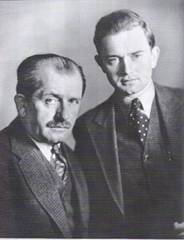
1909
Ferdinand Anton Ernst Porsche, later known as ‘Ferry’, is born on September 19 in Wiener Neustadt.
1910
The Austro-Daimler touring car designed and driven by Ferdinand Porsche scores a triple victory in the Prinz-Heinrich Race, which was popular at that time. It was a long-distance test for touring cars with annual varying routes. On that particular year, it was 1,495 kilometres long, and extended from Berlin through Magdeburg, Braunschweig, Kassel, Würzburg, Nuremberg, Stuttgart, Strasbourg and Trier to the finishing point at Bad Homburg. Ferdinand Porsche reached top speeds of up to 140 kilometres per hour on the track with his novel, aerodynamic, tulip-shaped car.
Creating the Austro-Daimler "Sascha", he also developed a small car able to successfully beat competitors with much larger engines in the 1922 Targa Florio in Sicily, ultimately scoring no less than 43 racing wins.
1923
As Technical Director and Board Member of the Daimler-Motoren-Gesellschaft in Stuttgart, Ferdinand Porsche designs the legendary Mercedes Compressor Sports Car. The following year, the 2-litre racecar wins the Targa Florio. The Mercedes-Benz S-Type models dominate international motorsport from 1927. His compressor designs Mercedes-Benz S (sport), SS (super sport) and SSK (super sport kurz (short)) became synonymous for sportiness and racing success.
In January 1929 Porsche left Daimler-Benz AG and spent a short time with Steyr-Werke in Austria. With the Wall Street crash of 1929, Ferdinand Porsche lost his position at Steyer, and despite his reputation he was unable to find a company willing to meet his directorship demands so he decided to set up his own company based in Stuttgart. With the financial backing of Adolf Rosenberger, Porsche started his company with some former co-workers. Most prominent amongst his new employees was his Chief Designer Karl Rabe.
1931
Ferdinand Porsche opens an office for ‘engineering and consultation on engine and vehicle design’ in Stuttgart on April 25, and worked for such renowned manufacturers as Wanderer, Zündapp and NSU.
In its first year, Porsche’s office developed a six-cylinder midrange saloon and a new straight-eight power unit for German car maker Wanderer based in the city of Chemnitz. This was followed by a swing axle for Horch-Werke in Zwickau and an air-cooled five-cylinder radial engine developed on behalf of Phänomen Werke in Zittau and intended for use in trucks.
Working on behalf of Zündapp GmbH, the Engineering Office also developed a small and compact car which, with its engine positioned at the rear, a central tube frame and the transmission upfront of the rear axle, was to pave the way for the Volkswagen Beetle destined to follow later. A further milestone in the history of the automobile was the torsion bar suspension concept patented by Porsche and featured for many decades as state-of-the-art technology in international car production.
Auto Union & VW
1933
For Auto Union, Porsche develops a Grand Prix race car with a 16-cylinder engine in mid-ship configuration. The rear-engine vehicle concept designed for the compact car (Type 32) developed for NSU is ultimately incorporated in the Volkswagen Beetle.
Porsche’s team led by Senior Engineer Karl Rabe started work on the mid-engine Auto Union P racing car (the "P" stands for Porsche). The first test drives were conducted as early as in January 1934, and in its very first racing season also in 1934 the new car not only set up three world records, but also won three international Grand Prix races as well as several hillclimb events.
With drivers such as Bernd Rosemeyer, Hans Stuck or Tazio Nuvolari at the wheel, the Auto Union racing car consistently enhanced to an ever-increasing standard between 1934 and 1939 became one of the most successful racing cars in the pre-war era. Indeed, its mid-engine concept soon set the trend for all modern racing cars and is still applied today in Formula 1.
See here for more details of the Auto Union Type C, and here for more history behind the Auto Union cars.

The Beetle
1934

The company Dr. Ing. h.c. F. Porsche KG receives an official order for the design and construction of a German Volkswagen. Only one year later, the VW prototype is test driven. The ‘Ur Beetle’ is assembled in the garage of the Porsche villa in Stuttgart.
Although it has to be said that much of the Beetle's design was most likely inspired by the Tatra cars of Hans Ledwinka, particularly the T97. This also had a streamlined body and a rear-mounted 4 cylinder horizontally-opposed air-cooled engine. Tatra sued, but the lawsuit was stopped when Germany invaded Czechoslovakia. The matter was re-opened after WW2 and in 1961 Volkswagen paid Tatra 3,000,000 Deutsche Marks in settlement.
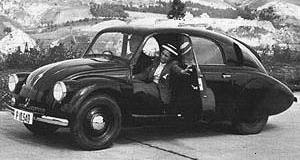
The Volkswagen company owes its postwar existence largely to one man, British army officer Major Ivan Hirst (1916–2000). After the war, he was ordered to take control of the heavily bombed factory, which the Americans had captured. He persuaded the British military to order 20,000 of the cars, and by 1946 the factory was producing 1,000 cars a month. The car and its town changed their Nazi-era names to Volkswagen (people's car) and Wolfsburg (not KdF as in Stadt des KdF-Wagens, a planned town built to house VW workers) respectively. The first 1,785 Beetles were made in a factory near Wolfsburg in 1945.
1935
Ferdinand Alexander Porsche is born on December 11 in Stuttgart as the eldest son of Ferry Porsche.
1936
Parallel to road trials of the Type 60, production facilities are erected under the direction of Ferdinand Porsche for the Volkswagen renamed the ‘KdF-Wagen’.
1939
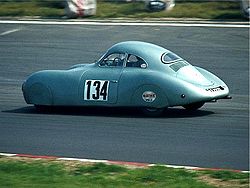
Finally, in April 1939 production started on the KdF-wagen but only 210 were made before World War 2 (1939-1945) disrupted the Western World and bombing ruined the factory.
Under the designation Type 64, three racing coupés are developed at Porsche in Zuffenhausen. Built for long-distance (Berlin to Rome) endurance competition, the ‘BerlinRom-Wagen’ are considered the forefathers of all later Porsche sports cars. See here for more details
Based on the Volkswagen Type 60, the Type 64 was seen by the "Kraft durch Freude" (KdF "Strength through Joy") movement as the ideal model for promoting sales of the Volkswagen now re-named the "KdF Car. By 1939 Porsche had completed three racing coupés boasting a streamlined aluminium body and powered by a modified VW horizontally opposed engine but then the Berlin-Rome Race planned for September 1939 was postponed due to the War.
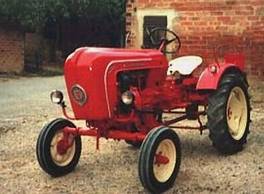 Apart from the Volkswagen Project, Porsche’s
Engineering Office, which had moved to the Zuffenhausen District of Stuttgart
in 1938, was also working on numerous other development assignments for the
automotive industry. Under a contract concluded with Daimler-Benz AG, for
example, Porsche developed technical engine components for the Mercedes
Silberpfeile, and worked on the Type 80 World Speed Record Car from 1937 to
1939.
Apart from the Volkswagen Project, Porsche’s
Engineering Office, which had moved to the Zuffenhausen District of Stuttgart
in 1938, was also working on numerous other development assignments for the
automotive industry. Under a contract concluded with Daimler-Benz AG, for
example, Porsche developed technical engine components for the Mercedes
Silberpfeile, and worked on the Type 80 World Speed Record Car from 1937 to
1939.
Yet another project was the Type 110 compact
tractor for farm use developed on behalf of the "Deutsche
Arbeitsfront" ("German Workers’ Front") (DAF) with its
air-cooled two-cylinder power unit, setting the foundation for the subsequent
"People’s Tractor" and the Porsche diesel tractor built after World
War II.
See also http://www.butzi.cz/porsche/modely/tractor-type-110.html
The Kastenwagen, Kübelwagen & Schwimmwagen
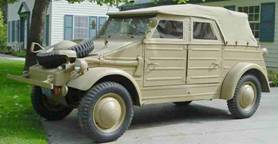 Following the outbreak of World War II, the
Porsche Engineering Office developed further models intended for military use.
Apart from the Type 81 VW "Kastenwagen" or Jeep, the company
re-established in late 1937 as Porsche KG, also developed the Type 62 KdF
Offroader, the Type 82 VW "Kübelwagen", the all-wheel-drive Type 87,
and the Type 166 VW "Schwimmwagen" or amphibian car.
Following the outbreak of World War II, the
Porsche Engineering Office developed further models intended for military use.
Apart from the Type 81 VW "Kastenwagen" or Jeep, the company
re-established in late 1937 as Porsche KG, also developed the Type 62 KdF
Offroader, the Type 82 VW "Kübelwagen", the all-wheel-drive Type 87,
and the Type 166 VW "Schwimmwagen" or amphibian car.
The Kubelwagen was the equivalent of the American Jeep during WWII. It was first designed by Dr. Ferdinand Porsche and by his son Ferry as a "buggy" for fun. With the war looming on the horizon, the "fun car" became a military vehicle. The base is from the KDF (the future Volkswagen). Only the rear wheels are driven but the car is very light and behaves well in rough conditions. Kübelwagen is an abbreviation from German Kübelsitzwagen which literally means "bucket seat car". It was a generic name for open-topped military utility cars fitted with bucket seats.
Ferdinand Porsche developed a four-wheel-drive version of the Kübelwagen. There were a few Type 86, a 4WD version of the Type 62 prototype, but then this was abandoned in favour of the Type 87, a 4WD version of the production type 82 (1941). Again, only a handful were manufactured (probably six, in Stuttgart, not Wolfsburg), but this vehicle is, historically important: it was the first Porsche-built car to have a 1086 cc engine. This engine featured the standard VW crankshaft, but with 73.5 mm (2.9 in) cylinder bores, and was later used in the Porsche 356.
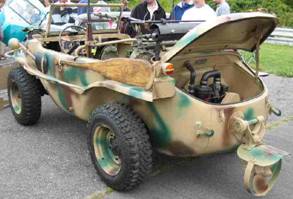
The entire 4WD Kübelwagen project was abandonned in favour of the Schwimmwagen, type 128/166.
The VW-Schwimmwagen (Porsche Type 128 and Type 166) was an amphibious vehicle used extensively by the German Wehrmacht and the Waffen-SS during the Second World War. It was produced by the Volkswagen factory at Wolfsburg, with the bodies (or rather hulls!) produced by Ambi Budd in Berlin. Erwin Komenda, Ferdinand Porsche's first car body designer, developed the car body construction. Komenda patented his ideas for the swimming car at the German Patent office.
All Schwimmwagens were four wheel drive (even the earlier Type 128, based on the full-length Kübelwagen chassis (2.4 m (7.9 ft) wheelbase). The large-scale production models (Type 166) had a wheel-base of only 2.0 m (6.6 ft).
Towards the end of 1939, Porsche’s Engineering Office was requested by the Armament Authority of the German Army to develop a medium-weight battle tank, but work on this model was discontinued in the middle of the project since there was greater demand for heavier tanks. So developing the Tank 101 "Tiger", Porsche KG submitted its bid for a tender organised by the Army Armament Authority for the construction of a tank in the weight category above 50 tonnes. And indeed, in 1942 Ferdinand Porsche received the assignment to build a very heavy armoured car subsequently to become known as the Tank 205 "Maus". But ultimately only two prototypes were built and the "Maus" was never able to enter battle.
1944
Owing to wartime conditions, the Porsche KG engineering office moves to Gmünd in the Austrian province of Carinthia. The company was only able to develop and sell water turbines, cable winches, ski-lifts, mowing rods and various tractors based on the original People’s Tractor now marketed for the first time under the name Porsche.
Ferdinand Porsche was arrested by the French at the end of 1945, and was subsequently held for 22 months in various prisons.
1946
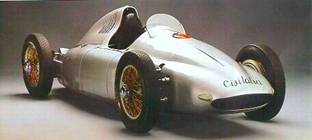
The Italian company Cisitalia entrusted Porsche KG now under the management of Ferdinand Porsche’s son Ferry with a number of comprehensive development contracts. Apart from a small tractor and a water turbine, the company developed and built the all-wheel-drive Type 360 Grand Prix racing car as well as a two-seater mid-engined all wheel drive sports car. See here for more detail.
356
1948
The 356 is the first sports car to bear the Porsche name, based on the Type 64 Berlin-Rome race car. ‘No. 1’ is road certified in June. Only one month later, the lightweight mid-engine roadster wins its first class victory at the Innsbruck Stadtrennen. Porsche No 1 was a mid-engined roadster, and was completed and homologated in the Austrian town of Gmünd. The engine displaced 1131 cc and developed maximum output of 35 bhp (26 kW). The first few 356 coupés are made of light alloy. See here for more details

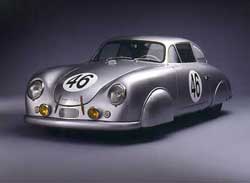
This marked the birth of the Porsche sports car brand, with production of the rear-engined coupé and cabriolet versions of the 356 starting in the second half of 1948. After returning to Stuttgart in 1950, Porsche began regular series production of the 356, with a total production volume of some 78,000 units by the year 1965.
1950
Start of production back in Stuttgart.
1951
The Porsche 1300 (1286 cc, 44 bhp/32 kW) and 1500 (1488 cc, 60 bhp/44 kW) join the range, the latter quickly becoming a best seller.
At the age of 75 Professor Dr. Ing. h.c. Ferdinand Porsche died 1951 in Stuttgart.
1952
Launch of the Porsche 1500 S (1488 cc, 70 bhp/51 kW).
1953
Yet another new model joins the range: the Porsche 1300 S (1290 cc, 60 bhp/44 kW).
550 & 718
 The Porsche 550 is produced from 1953-1956. Inspired by the 356 and some spyder prototypes, the car was designed for use in racing. The 550 / 1500RS or Spyder became known as the "Giant Killer", and gave Porsche its first overall win in a major sports car racing event, the 1956 Targa Florio. Its successor from 1957 onwards, the Porsche 718, was even more successful, scoring points in Formula One as late as 1963. A descendant of the Porsche 550 is generally considered to be the Porsche Boxster S 550 Spyder; the Spyder name was effectively resurrected with the RS Spyder Le Mans Prototype. The Porsche 550 "Little Bastard" is best known for being the car in which James Dean was killed in 1955.
The Porsche 550 is produced from 1953-1956. Inspired by the 356 and some spyder prototypes, the car was designed for use in racing. The 550 / 1500RS or Spyder became known as the "Giant Killer", and gave Porsche its first overall win in a major sports car racing event, the 1956 Targa Florio. Its successor from 1957 onwards, the Porsche 718, was even more successful, scoring points in Formula One as late as 1963. A descendant of the Porsche 550 is generally considered to be the Porsche Boxster S 550 Spyder; the Spyder name was effectively resurrected with the RS Spyder Le Mans Prototype. The Porsche 550 "Little Bastard" is best known for being the car in which James Dean was killed in 1955.
1954
Production of the first 200 Porsche Speedsters.
1955
The Speedster becomes a genuine sales success. Production of the 356 A series starts in autumn with the proven 1300 and 1300 S power units soon joined by the 1600 (1582 cc, 60 bhp/44 kW), 1600 S (1582 cc, 75 bhp/55 kW) and 1500 GS the first Carrera marking the introduction of the new sports engine with four overhead camshafts (1498 cc, 100 bhp/74 kW). The 1100-cc engines are dropped from the range.
1956
No changes within Porsche's model range.
1957
The sporting and spartan Porsche 1500 GS Carrera is joined by the more comfortable 1500 GS de Luxe model.
1958
Output of the Porsche 356 A 1500 GS Carrera GT is boosted to 110 bhp/81 kW. The Speedster is replaced by the Convertible D with a larger windscreen and winding windows at the side. The 1300-cc engines are dropped from the range.
1959
The Carrera receives extra power and is now called the 1600 GS-GT, with the sports version offering more output (1588 cc, 115 bhp/85 kW) than the de Luxe model (105 bhp/77 kW). The 356 B series is introduced in autumn, the Convertible D being re-named the Roadster.
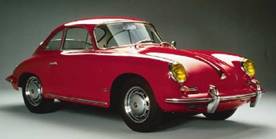 1960
1960
The Porsche Super 90 (with a special balance spring on the rear axle) joins the 356 range (1582 cc, 90 bhp/66 kW).
The Type 695, also known as the T7 prototype appears, giving hints of the 911 to come.

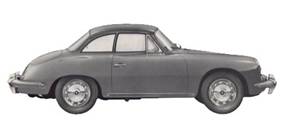 1961
1961
Karmann, the specialist coachbuilder, builds the hardtop coupe on behalf of Porsche. The roof is not removable, the silhouette of the car has a slight notchback look.
See here for more details
1962
The Porsche 356 is introduced in autumn. Disc brakes are now standard on all models, with disc brakes on all four wheels being the most significant innovation.
The two "standard" models in the range are the 1600 C (75 bhp/55 kW) and 1600 SC (95 bhp/70 kW). The new top model is the Carrera 2 (1966 cc, 130 bhp/96 kW) featuring inner-grip brake callipers on the brake discs.
911
1963
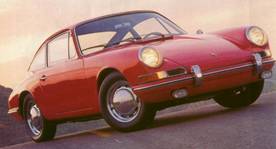
The Porsche 911 makes its appearance in the market. The first version of the new six-cylinder boxer engine offers the same output as the Carrera 2 (1991 cc, 130 bhp/96 kW). See here for more details
Originally named the 901, it turned out that Peugeot claimed rights to that model designation, so Porsche changed the name to 911.
The stylish 911, with design work by Butzi Porsche, was an instant hit with the fashionable upper and middle classes; but the air-cooled six cylinder, rear-engined 911 had unpredictable handling on the limit which gained it a reputation for violent skids and untimely trips off-road. Amazingly the handling woes were temporarily cured by fitting heavy metal weights into the front bumper of each 911 built, improving its balance.
1964
Start-up of Porsche 911 production. The 356 C is selling better than ever before.
912
1965
The new model series is rounded off at the lower end by the 912 with its flat-four power unit (1582 cc, 90 bhp/66 kW) quickly becoming a best seller. Production of the 356 ends in April. See the 912 register here and a spec of the 912 from 1967 here
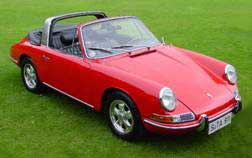
1966
The Porsche Targa complete with roll-bar enters the range in autumn as the new open-air model with a removable roof section between the windscreen and roll hoop. It was named after the Targa Florio road race and proved a popular addition to the range.
The 911 S is introduced with an even more powerful engine (160 bhp/118 kW). By the end of the year the 912 is out-selling the 911.
 The Porsche 906 (Carrera 6) was announced in 1966, with Gullwing doors and aerodynamic bodywork, it epitomised sports car racing of the era, & was the was the last street-legal racing car from Porsche. More details on the 906 here
The Porsche 906 (Carrera 6) was announced in 1966, with Gullwing doors and aerodynamic bodywork, it epitomised sports car racing of the era, & was the was the last street-legal racing car from Porsche. More details on the 906 here
Designed by Dr Ferdinand Piech, this car was to be the replacement for the ageing 904 which, after dominating hillclimbing for a good few years was losing out to the Ferrari Dino. The car led to a string of highly successful racing sports cars, culminating in the 917K which was the first win at Le Mans for Porsche in 1970.
1967
The 911 T joins the six-cylinder model series with leaner trim and a less powerful engine (110 bhp/81 kW), selling at a very attractive price of less than DM 20,000.-. US exports increase rapidly.
1968
Wheelbase of the 911 is extended by 57 mm or 2.24". To comply with US emission standards, the six-cylinder power units feature Bosch mechanical fuel injection for the first time. The 911 E (140 bhp/103 kW) is launched into the market, output of the 911 S is boosted by 10 bhp to 170 bhp. The 911 T still using carburettor technology develops maximum output of 110 bhp/81 kW.
914
1969
To name only the most important innovations, the 911 receives a larger 2195-cc power unit for the 1970 model year, introducing a new power and performance league: 911 T (125 bhp/92 kW), 911 E (155 bhp/114 kW), 911 S (180 bhp/133 kW). Semi-automatic Sportomatic is available as an option.
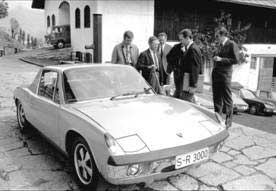
The Porsche 912 is replaced by the two-seater mid-engine VW Porsche 914 available in two versions: as the 914/4 with a four-cylinder Volkswagen engine (1679 cc, 80 bhp/59 kW) and as the 914/6 with a six-cylinder Porsche power unit (1991 cc, 110 bhp/81 kW). Particularly the low-priced four cylinder becomes a genuine success.
1971
The six-cylinder featured in the 911 grows once again, displacing 2341 cc and introducing a new power and performance league once again: 911 T (130 bhp/96 kW), 911 E (165 bhp/121 kW), 911 S (190 bhp/140 kW).
 Porsche also puts on the pressure with its
"small" model, building 11 916 sports cars featuring the
ultra-powerful six-cylinder (2341 cc, 190 bhp/140 kW), following the two 914/8
models with an 8-cylinder racing engine already built two years before (2997
cc, but varying in power: 260 bhp/191 kW and 300 bhp/221 kW). The 260-bhp 914/8
goes to Professor Ferry Porsche for his 50th birthday.
Porsche also puts on the pressure with its
"small" model, building 11 916 sports cars featuring the
ultra-powerful six-cylinder (2341 cc, 190 bhp/140 kW), following the two 914/8
models with an 8-cylinder racing engine already built two years before (2997
cc, but varying in power: 260 bhp/191 kW and 300 bhp/221 kW). The 260-bhp 914/8
goes to Professor Ferry Porsche for his 50th birthday.
In 1971, Porsche’s development division with its construction, testing and design departments moved to the new Weissach development centre 15 miles north-west of Stuttgart-Zuffenhausen. Apart from a large test track, Weissach also became the home of further elaborate installations such as a wind tunnel, a crash test facility, the exhaust emissions test centre, and a wide range of drivetrain test stands and dynamometers serving for both in-house developments and customer assignments.
1972
The Porsche 911 Carrera RS 2.7 (2687 cc, 210 bhp/154 kW) and the Porsche 2.8 Carrera RSR (2806 cc, 300 bhp/ 221 kW) pave the way for further growth. Destined mainly for motor racing, these new models introduce a clearly visible aerodynamic body feature for the first time: the ducktail rear spoiler on the engine compartment lid. The Porsche 914 receives extra power, now featuring a larger four-cylinder from VW (1971 cc, 100 bhp/74 kW) helping the "small" Porsche to remain a genuine best seller.
1973
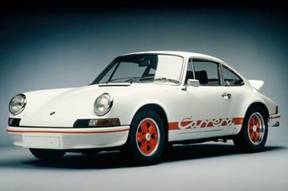 Following the plant shut-down in summer the
new model range reveals significant modifications in body design, the bumpers
now complying with US regulations and featuring impact absorbers at either
side. The 2.7-litre power unit (210 bhp/154 kW) is introduced as standard in
the Porsche 911. New models are the Carrera RS 3.0 sports version (2994 cc, 230
bhp/168 kW) and the Carrera RSR 3.0 (2994 cc, 330 bhp/241 kW) featuring a large
rear wing and flared wheel arches with special air intakes.
Following the plant shut-down in summer the
new model range reveals significant modifications in body design, the bumpers
now complying with US regulations and featuring impact absorbers at either
side. The 2.7-litre power unit (210 bhp/154 kW) is introduced as standard in
the Porsche 911. New models are the Carrera RS 3.0 sports version (2994 cc, 230
bhp/168 kW) and the Carrera RSR 3.0 (2994 cc, 330 bhp/241 kW) featuring a large
rear wing and flared wheel arches with special air intakes.
Within the 914 series a 1.8-litre version (1795 cc, 85 bhp/63 kW) replaces the former 1.7-litre engine.
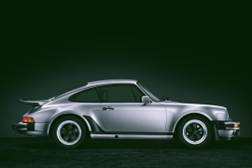 930
930
1974
In autumn the first Porsche Turbo code-named the 930 (2994 cc, 260 bhp/191 kW) sees the light of day, providing the foundation for various racing models code-named the 935 in the years to follow, with maximum output up to 850 bhp. The 911 is available in three versions with the same 2687-cc displacement engine but different levels of power: 911 (150 bhp/110 kW), 911 S (175 bhp/129 kW) and the Carrera (210 bhp/154 kW). The sales split is almost exactly 50:50.
1975
The Porsche 911 enters the 1976 model year with only very minor modifications. Output of the "basic" version is boosted to 165 bhp/121 kW, the 911 S is dropped from the range. The Carrera 3.0 (2994 cc, 200 bhp/147 kW) is dropped after the plant shut-down in summer. In their last year of production, all models in the Porsche 914 range receive a two-litre power unit, with a reduction in compression and output to 95 bhp/70 kW. In autumn the 912 E (available only in the USA) also featuring a VW power unit (1971 cc, 90 bhp/66 kW) joins the 914 in the market.
924
Porsche's new entry-level model is the 924, the first-ever Porsche with a water-cooled engine fitted up front an engine supplied by Audi (1984 cc, 125 bhp/92 kW). The 911 model range continues with a 2.7-litre power unit as well as the 3.0-litre in the Carrera, output remaining unchanged in both cases.
The bodyshell hot-galvanised on both sides significantly extends the life-cycle of all Porsche models from 1976.
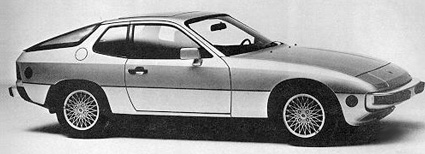
928
1977
 The Porsche 928 launched in autumn 1977 is
the new top model conceived as the successor to the 911. Its V8 power unit
boasts American dimensions (4474 cc, 240 bhp/177 kW). Starting in autumn, all
models in the 911 range receive the 3.0-litre engine with the same output (180
bhp/132 kW) no longer comparable to the former performance figures due to the
new emission standards in the market.
The Porsche 928 launched in autumn 1977 is
the new top model conceived as the successor to the 911. Its V8 power unit
boasts American dimensions (4474 cc, 240 bhp/177 kW). Starting in autumn, all
models in the 911 range receive the 3.0-litre engine with the same output (180
bhp/132 kW) no longer comparable to the former performance figures due to the
new emission standards in the market.
The Turbo engine becomes larger and even more powerful (3299 cc, 300 bhp/221 kW), with an intercooler. The rear spoiler changed its looks over the earlier Turbo. The brakes were huge cross drilled items from the 917 racing car (a good way to spot a genuine Turbo), and a boost gauge is incorporated into the rev counter.
Sales of the 924 remain at a good level, the 911 is a stable performer as before, and demand for the Turbo as well as the 928 continues to develop positively. From now on the 911 bears the model name "Porsche 911 SC".
1979
Output of the 911 increases slightly to 188 bhp/138 kW. The 924 Turbo also comes close to this figure, at 170 bhp/125 kW. With its technical features remaining unchanged, the 928 sees an increase in production and sales, the 924 remaining Porsche's best seller.
1980
The Porsche 924 Carrera GT (210 bhp/154 kW) offers even more power than the 911, the 911 SC now featuring a 204 bhp/150 kW engine. The 928 remains unchanged, but is joined by the 928 S developing maximum output of 300 bhp/221 kW from 4664 cc.
1981
On goes the trend to even more power and performance, the 924 Turbo now featuring a 177 bhp/130 kW power unit. In 1981 the engine ran on high octane 98 fuel (earlier it ran on 92 octane) and increased its HP to 204. In addition to the power increase the fuel economy got much better. The 911 Turbo remains unchanged. At the Frankfurt Motor Show Porsche presents a concept Turbo Cabriolet (with four-wheel drive).
944
1982
 Porsche extends the range by introducing the
944 based on the 924 but featuring even wider wheel arches and a four-cylinder
Porsche engine (2479 cc, 163 bhp/120 kW) basically speaking half the
8-cylinder in the 928. The new model has a clear effect on sales of the 924,
which start to go down for the first time.
Porsche extends the range by introducing the
944 based on the 924 but featuring even wider wheel arches and a four-cylinder
Porsche engine (2479 cc, 163 bhp/120 kW) basically speaking half the
8-cylinder in the 928. The new model has a clear effect on sales of the 924,
which start to go down for the first time.
1983
After almost 20 years Porsche returns to a real convertible, the 911 SC Cabriolet becoming a best seller right from the start. Output of the 928 S is increased moderately to 310 bhp/228 kW.
1984
The 1984 model year launched in September 1983 once again introduces the 911 Carrera with an even larger engine (3164 cc, 231 bhp/170 kW). Arguably the best engine ever because of the good combination of power, reliability, economy and driveablity. The 3.2 runs on 98 octane fuel like the last SCs did. It has hydraulic timing chain tensioners and put an end to a weak point in the 911 history. The engine has DME electronically controlled ignition and injection system that improves the driveability and fuel economy. The new manifolds are very characteristic and makes it easier to recognise a 3.2 liter engine. The brakes are thicker and better, the ventilation system is improved.
On non european markets the Carrera gets a catalytic converter, HP was 207.
The Company's success curve points upwards, the 924 and 944 remaining the best-selling models. The 928 S becomes even more powerful, all 911 Carrera models are now also available in Turbo look.
959
1985
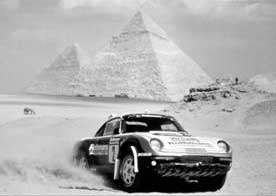 The year of the 959 featuring a four-valve boxer engine, water-cooled cylinder heads,
four-wheel drive, awe-inspiring performance figures (2850 cc, 450 bhp/331 kW)
and a price tag of DM 420,000.-. Production of the 959 in the years to come
exceeds the 200 mark. The Porsche 928 features an even larger engine for the
US and Japan, with output closer to the European model (4957 cc, 292 bhp/215
kW).
The year of the 959 featuring a four-valve boxer engine, water-cooled cylinder heads,
four-wheel drive, awe-inspiring performance figures (2850 cc, 450 bhp/331 kW)
and a price tag of DM 420,000.-. Production of the 959 in the years to come
exceeds the 200 mark. The Porsche 928 features an even larger engine for the
US and Japan, with output closer to the European model (4957 cc, 292 bhp/215
kW).
The Porsche four-cylinder in the 944 now offers even more power thanks to turbocharging (2479 cc, 220 bhp/162 kW), both the 924 and the 944 remaining on the best-selling list.
Without any significant modifications the Porsche 911 achieves its best annual result, just as the 928 S shows good year-round figures even without any significant innovations. The 924 matures into the 924 S now featuring Porsche's four-cylinder power unit (2479 cc, 150 bhp/110 kW).
1986
The four-valve Porsche 928 S4 goes into production with an increase in engine size and power (4957 cc, 320 bhp/ 235 kW). The new range consists of the 924 S/944 (2457 cc, 150 bhp/110 kW), the 944 S (2457 cc, 190 bhp/140 kW) and the 944 Turbo (2457 cc, 220 bhp/162 kW). The 911 Turbo is also available in both Targa and Cabriolet guise.
In 1986 the European Carrera becomes available with catalytic converter. This lowers the HP to 217.
1987
Output of the 924 S/944 models increases to 160 bhp/118 kW. The 944 Turbo S (2479 cc, 250 bhp/184 kW) rounds off the small model series, the Porsche 928 S4 remains in production without any significant changes.
For the Carrera, the old 915 gearbox is replaced with the all new G50 gearbox. This also means that the old cable operated clutch is replaced with a hydraulic clutch. This new gearbox is easier to use and the hydraulic clutch is a bit less demanding than the earlier clutch (which was a bit heavy).
964
1988
 The new generation of the 911 comes with the
in-house code designation 964. Introduction of the new model starts with the
911 Carrera 4 featuring four-wheel drive. The 964 series is available first as
a coupé, its six-cylinder boxer engine featuring double ignition, plus extra
size and power (3600 cc, 250 bhp/ 184 kW). The old series remains in production
with the 911 Speedster, strictly a two-seater with an extra-small windscreen.
The new generation of the 911 comes with the
in-house code designation 964. Introduction of the new model starts with the
911 Carrera 4 featuring four-wheel drive. The 964 series is available first as
a coupé, its six-cylinder boxer engine featuring double ignition, plus extra
size and power (3600 cc, 250 bhp/ 184 kW). The old series remains in production
with the 911 Speedster, strictly a two-seater with an extra-small windscreen.
The Porsche 944 comes with a larger engine (2681 cc) and more power (165 bhp/121 kW) and is joined by the 944 Turbo (250 bhp/184 kW). The four-valve power unit of the 944 is increased in size and output to 2990 cc, 211 bhp/155 kW. The 944 S2 is available as both a coupé and cabriolet, the 944 Turbo receives an all-new five-speed gearbox.
1989
The first all-new 911 came in 1989, at a time of a global economic recession which undoubtedly dented sales success. The car was an evolution of the classic 911 ‘teardrop’ shape of its predecessor, but more than 80 per cent of its parts were new - including a larger 3.6-litre 6-cylinder engine. And, for the first time, 911 owners could experience four-wheel-drive and the extra grip it offered in the Carrera 4 model.
The 911 is now available with rear-wheel drive as the Carrera 2, coming in both Targa and Cabriolet form. Tiptronic is introduced at the same time, automatic transmission with a torque converter and four gears also allowing a sequential gearshift by means of the selector lever. The large model series is rounded off as of spring 1989 by the 928 GT with even more power (330 bhp/243 kW). The 911 Turbo is dropped from the range, production ceasing in autumn 1989.
In 1989 the Carrera is only available with the 217 HP catalytic converter specification. The 1989 Carrera is considered by many to be the last of the real 911s. Later models have much more electronic equipment and a more modern look. In 1989 the Turbo finally gets a five speed gearbox. The earlier Turbos were only available with a 4 speed gearbox.
1990
The new 911 Turbo enters the market in September with a 3299 cc power unit and a slight increase in power (320 bhp/235 kW).
The 964 also available with normal rear wheel drive. So now the 911 is available as the 911 Carrera 2 and the 911 Carrera 4. You can still get them in Coupe, Targa or Cabriolet shape. The rear spoiler is electrically controlled and raises itself at 80 km/h.
968
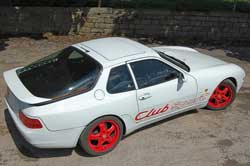 1991
1991
The Porsche 968 based in its design on the 928 replaces the 944. Output of the three-litre power unit is boosted to 240 bhp/176 kW. The 8-cylinder power unit of the Porsche 928 now featured in the GTS increases in both size and output (5397 cc, 350 bhp/257 kW), just as the 911 Carrera RS competition model also offers a slight boost in power (260 bhp/191 kW).
The 968 Clubsport appears later in 1993.
See also http://www.porsche968uk.co.uk/
In 1991 a new 911 Turbo appears. It still has a 3.3 liter engine, but looks like the 964 models although with a traditional Turbo rear spoiler (a 964 Turbo is often called a 965). The HP output is 320 (could be ordered with 360).
1992
The Porsche 911 Turbo comes with an even larger engine displacing 3600 cc and developing 360 bhp/265 kW, 0 to 100 km/h in 4.6 seconds according to the german magazine Auto Motor & Sport. This car is the last of the classic rear wheel drive Turbos. It is instantly recogniseable by its 18 inch split wheels.
The 968 is introduced in two-seater Clubsport trim with leaned-down equipment and a lower price.
993
1993
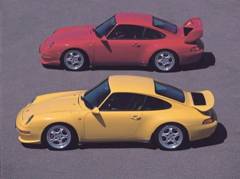 Towards the middle of the year Porsche
presents the thoroughly modified 911 code-named the 993 within the Company and
featuring an even more streamlined body, the new multi-link rear axle and a
choice of either six-speed manual gearbox or four-speed Tiptronic. Engine
capacity remains unchanged, output increases even further (3600 cc, 272 bhp/200
kW). The new 993 is built initially as the Carrera coupé with rear-wheel drive.
Towards the middle of the year Porsche
presents the thoroughly modified 911 code-named the 993 within the Company and
featuring an even more streamlined body, the new multi-link rear axle and a
choice of either six-speed manual gearbox or four-speed Tiptronic. Engine
capacity remains unchanged, output increases even further (3600 cc, 272 bhp/200
kW). The new 993 is built initially as the Carrera coupé with rear-wheel drive.
Many Porsche followers believe the 993 is the ultimate 911, for its mix of classic and modern looks and breathtaking performance. It was the last 911 model with an air-cooled heart and even the lowliest model had 270bhp.
The 993 generation also bore the RUF Yellow Bird – a car tuned to such an extent it took on the name of its builders RUF and was no longer called a Porsche.
The traditional Targa is no longer available. A new concept with a back sliding glass roof is introduced instead.
A completely new Turbo comes along with 4 wheel drive and 2 turbochargers instead of 1. It has hollow spoke 18 inch wheels and 408 HP. It was possible to order it with 430 HP or even 450 HP from the "Sonderwunschabteilung". This Turbo (often referred to as Turbo 4) can brake from 100 km/h to 0 in 2.5 seconds and 35 meters.
GT2
The Porsche 911 (993) GT2 is launched as a Le Mans racing homoglation special. In near-racing spec suspension and with 430bhp it accelerates from 0-60mph in 4-seconds and hits 184mph and quickly gained a reputation for being rather unforgiving in the wrong hands.
In 1999, the 993-generation 911 was replaced with the 996 model, but it was anther two years before a new GT2 model arrived, & in that time Porsche had decided to abandon the GT2 for motorsports use, instead concentrating on the new naturally-aspirated 911 GT3.
The Porsche 996 911 GT2 was superseded by the 997-generation GT2 in 2007 and remained based on the 3.6 litre flat-6 engine, but featured twin variable geometry turbochargers, which generated 390 kW (523 hp) at 6500 rpm. The GT2 now accelerates in 3.6 seconds to 100 km/h (62 mph) and in 10.6 seconds to 200 km/h (124 mph) and has a maximum top speed of 331 km/h (206 mph). This makes it the first Porsche 911 to exceed the 200 mph (322 km/h) top speed, with the exception of the 1998 Porsche 911 GT1 which has a mid-mounted engine, unlike any other car bearing the 911 moniker. Like the 993 GT2, its body differed significantly from those of other 996s; major differences included wider fenders, a more aggressively-shaped nose, and a large rear wing.
1994
The new Carrera 4 enters production featuring a new drive concept with power transmitted to the wheels via a viscous coupling. As the "basic model" for racing Porsche builds the 911 Carrera RS with an extra-light body, a larger, fixed-position rear spoiler and a more powerful engine (3746 cc, 300 bhp/221 kW). In spring 1994 Porsche ceases production of the 993 Cabriolet.
1995
The new 911 Turbo displaces 3600 cc and develops maximum output of 408 bhp/300 kW. It also features the four-wheel-drive concept of the Carrera 4. The even more dynamic GT2 version of the Turbo, in turn, comes exclusively with rear-wheel drive and offers even more power (430 bhp/316 kW). In September the 911 Carrera also receives extra power (285 bhp/210 kW), and at the same time a new Porsche Targa with a sliding glass roof enters production.
GT1
The Porsche 911 GT1 was a racing car announced in 1995 for competition in the GT1 class at the 1996 24 Hours of Le Mans and sold as a road car for homologation purposes. The limited-production street-legal version was labeled the 911 GT1 Straßenversion (Street version). In spite of its name, the car actually has very little in common with the 911, its floorpan was taken from the 956/962 Group C sports-prototype racing car built by Porsche in 1982 for the FIA World Sportscar Championship. The GT1 featured a water-cooled, twin-turbocharged and intercooled, four valve per cylinder flat-six in a mid-mounted position and making about 600 hp (450 kW). In comparison, the 993 generation 911 GT2, which was otherwise the company's highest-performance vehicle, used an air-cooled engine with only two valves per cylinder and mounted in the rear, which was the traditional layout for the 911.
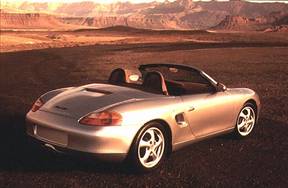 Boxster (986) & 996 (911)
Boxster (986) & 996 (911)
1996
Public launch of the Boxster (986) at the 1996 Paris Motor Show. A mid-engined roadster, the Boxster reveals Porsche's new generation of power units with very convincing facts and figures (2480 cc, 204 bhp/150 kW). Six water-cooled cylinders in horizontally opposed arrangement, four overhead camshafts with VarioCam, four valves per cylinder and integrated dry sump lubrication are the technical highlights.
The Boxster is Porsche's first vehicle designed from the beginning as a roadster; all previous Porsche convertibles were based on hardtop coupes. In 2000, the new Boxster S variant was introduced with a larger 3.2 litre motor, and the base model received a more powerful 2.7 litre engine. In 2003, styling and engine output was upgraded on both variants.
The Porsche 996 is the company's internal name for the version of the Porsche 911 model manufactured and sold between 1998 and 2005, later replaced by the Type 997. Both body styles were used in 2005, depending on model. At its debut, it featured the most significant changes to the Carrera model since its 1963 introduction. The most important among these is the fully water-cooled engine, replacing the previously air-cooled engines, used exclusively by the Carrera models - many "purists" consider the 996 to be an altogether different car because of this. It also featured a smooth nose, which moved away from the raised wings and headlights of its predecessors, and shared parts with the Boxster.
1998
The 911 Cabriolet based on the new model is presented to the public in March, its roof opening and closing electrohydraulically at the touch of a button. An aluminium hardtop comes as standard, as do the sidebags on both doors.
GT3
1999
The Porsche 911 GT3 was introduced in 1999 as a high performance version of the first water-cooled version of the Porsche 911, the 996, to continue the quarter-century tradition of low-weight RS (short for "Rennsport" in German) models that ended with the 993 RS. The GT3, named after the FIA GT class it was intended for, did not use the rather simple engine of the regular production versions of the 996, but a naturally-aspirated version of the turbocharged Porsche 962 and Porsche 911 GT1 race cars. Later, the turbo-charged Porsche 911 GT2 was added to the maker's lineup, but unlike its predecessor 993 GT2, did not fit into GT racing regulations. The racing versions of the GT3 have won several major 24h races outright, and mainly dominated their class at Le Mans. The 911 GT3 competes with the BMW M3 GTR and the Ferrari F430 GT2.
The following race versions were offered:
- 1999 996 GT3-R
- 2000 996 GT3 Cup
- 2001 996 GT3-RS
- 2004 996 GT3-RSR - with sequential gear box
- 2005 997 GT3 Cup
- 2007 997 GT-3 RSR
- 2008 997 GT3 Cup S
Cayenne
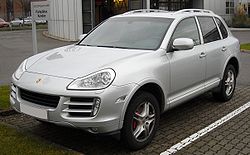
2002
The Porsche Cayenne is a five-seat mid-size luxury sport utility vehicle, with North American sales beginning in 2003. Its platform was developed and is shared with the Volkswagen Touareg and is the first V8 engined vehicle built by Porsche since 1995, when the Porsche 928 was discontinued.
Porsche Carrera GT & 997 (911)
2004
The 911 997 is immediately recognisable as a development of the 911 996, but reverting to the 911 trademark round headlights. The 911 997 Turbo packs an almighty 473bhp and 457lb/ft of pulling power, and a 0-60mph in 3.9 seconds before reaching 192mph. It’s also the first 911 with a model capable of more than 200mph – in GT2 guise with 530bhp.
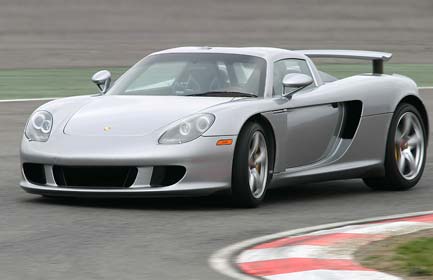
The Porsche Carrera GT (Project Code 980) is a mid-engined sports car developed with Le Mans in mind. The Carrera GT is powered by a 5.7 litre V10 engine producing 612 DIN (605 SAE) horsepower (450 kW), whereas the original concept car featured a 5.5 litre version rated at 558 hp (416 kW). Acceleration from 0 to 100 km/h (62.1 mph) in 3.9 seconds and a top speed of 330 km/h (205 mph)
Notable technology includes a pure carbon fiber monocoque and subframe, dry sump lubrication and inboard suspension. The carbon fiber monocoque and subframe were produced and assembled by ATR Composites Group of Italy. The spoiler of the Carrera GT extends into the air when the car reaches about 60 miles (97 km) an hour and evens out the air flow, which causes less drag. The Carrera GT radiator is about five times the size of a 911 Turbo's.
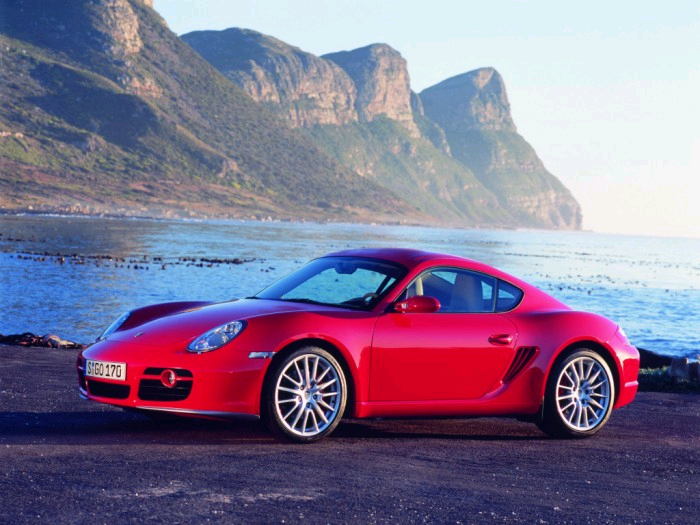 Cayman & Boxster 987
Cayman & Boxster 987
2005
Porsche unveiled the new generation of Boxsters: the type 987. The 987 is more powerful than its predecessor and featured styling inspired by the Carrera GT. Engine output increased in 2007, when both Boxster models received the engines from their corresponding Porsche Cayman variants. In 2009, the Boxster models received several new cosmetic and mechanical upgrades, further increasing engine output and performance.
The Porsche Cayman is launched as a mid-engined, rear wheel drive 2-seat sports coupé derived from Porsche's second generation Boxster convertible. Like the Boxster, most Caymans are assembled in Finland for Porsche by Valmet Automotive (the rest are assembled in Zuffenhausen near Stuttgart, Germany).
After two years of development, the first model of the coupé to be released was the Cayman S (type 987.120). Photographs and technical details were released in May 2005, but the public unveiling did not take place until the September Frankfurt Motor Show. The S suffix (an acronym for Sport or Special) indicated that this was a higher performance version of a then unreleased normal model. That model, the Cayman (987.110), went on sale in July 2006. A motorsport-tuned model, the Cayman RS, is rumored to have been tested at the Nürburgring that same year.
The Cayman coupé (project 987c) and the second generation Boxster convertible (project 987) share the same mid-engined platform and many components, including the front bumpers and boot lid, side doors, headlights, tailights and forward portion of the interior. The design of the Cayman's body incorporates styling cues from two classic Porsches; the 550 Coupé and the 904 Coupé. Unlike the Boxster, the Cayman has a large hatchback for access to luggage areas on top and in back of the engine cover. The suspension design is fundamentally the same as that of the Boxster, but features revised settings appropriate to the increase in chassis stiffness resulting from the Cayman's fixed roof. More details here
Panamera
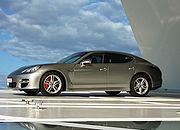 2009
2009
The Porsche Panamera is a four-door, four-seat luxury sedan; front-engined with rear wheel drive, with a four-wheel drive version also available.
The V8 normal-aspiration versions of the Panamera have rear-wheel drive as standard, while the Turbo version includes standard all-wheel drive with PTM (Porsche Traction Management). Currently, the engine choices include the base model S, 4S, and Turbo. US models include an engine start/stop system, and the Turbo version uses active aerodynamics with a multi-stage, adjustable rear spoiler.

